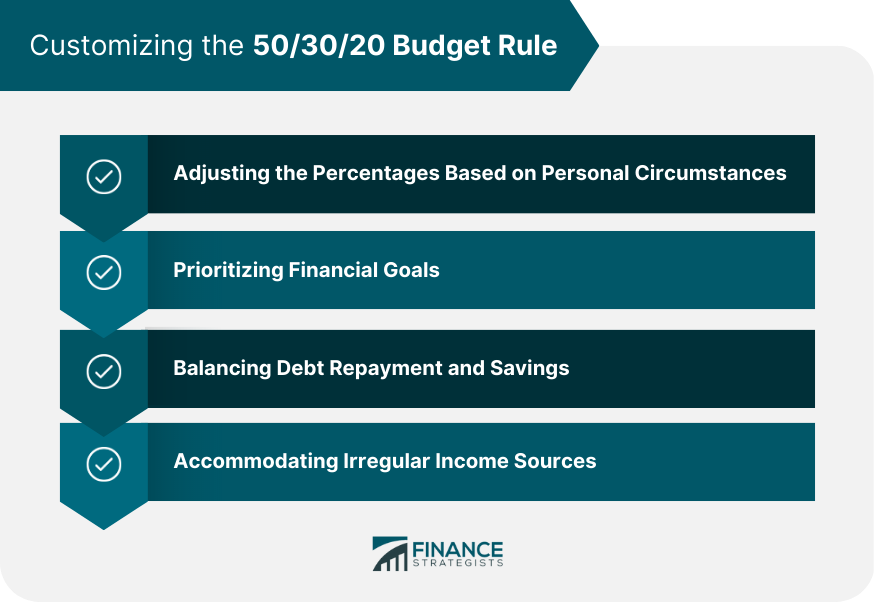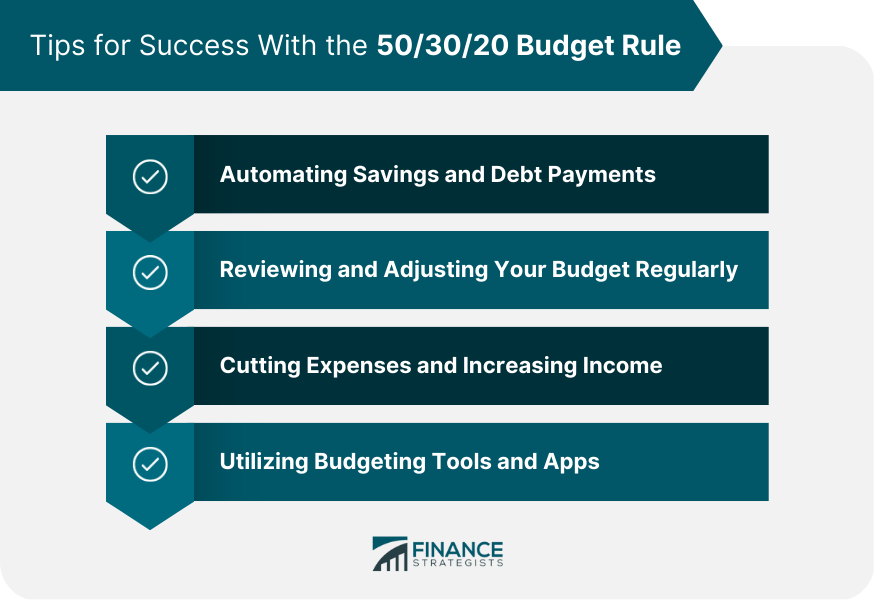The 50/30/20 budget rule is a simple and effective method for managing personal finances. This rule allocates after-tax income into three main categories: 50% for needs, 30% for wants, and 20% for savings and debt repayment. Budgeting is crucial for achieving financial stability and success. It helps individuals track their spending, identify areas for improvement, and plan for future financial goals. The primary goal of the 50/30/20 budget rule is to provide a straightforward framework for managing finances. This rule promotes financial responsibility, encourages saving, and helps individuals prioritize their spending to achieve a balanced financial lifestyle. This includes mortgage or rent payments, property taxes, homeowners or renters insurance, and any other housing-related expenses. Utilities encompass electricity, gas, water, and other essential services for maintaining a home. This category covers the cost of food and other essential household items. Transportation expenses include costs related to owning or leasing a vehicle, public transit, and other modes of transportation necessary for work or daily life. Essential insurance policies, such as health, life, and auto insurance, fall under this category. This encompasses the cost of meals and drinks consumed outside the home. Entertainment expenses include costs for movies, concerts, sporting events, and other leisure activities. This category covers the cost of pursuing hobbies and interests, such as art supplies, sports equipment, or club memberships. Travel expenses include costs associated with vacations, weekend getaways, and other non-essential trips. This category covers the cost of purchasing new clothing and accessories. An emergency fund is a savings account designed to cover unexpected expenses, such as medical bills or car repairs. This category includes contributions to retirement accounts, such as 401(k) plans, IRAs, or other retirement savings vehicles. Debt repayment includes payments toward credit card debt, student loans, personal loans, or other outstanding debts. This category covers contributions to education savings accounts, such as 529 plans or other college savings vehicles. This includes any additional financial goals, such as saving for a down payment on a home or starting a business. To begin implementing the 50/30/20 budget rule, calculate your after-tax income. This is the amount of money you have available to spend after accounting for federal, state, and local income taxes. Next, categorize your expenses into the three main categories: needs, wants, and savings and debt repayment. This process may require reviewing past bank statements, credit card bills, or other financial records to accurately determine your spending habits. Using the 50/30/20 rule, allocate your after-tax income to the appropriate categories. Ensure that 50% is dedicated to needs, 30% to wants, and 20% to savings and debt repayment. Regularly track your spending to ensure that you are adhering to the budget. This may involve using a spreadsheet, budgeting app, or simply keeping a written record of your expenses. As your financial situation changes, you may need to adjust your budget to ensure it remains accurate and effective. This could involve increasing or decreasing the allocations to various categories or revisiting your spending habits. The 50/30/20 rule can be customized to better suit your personal financial situation. For example, if you have a higher income, you may choose to allocate more toward savings and less toward wants. Conversely, if you have a lower income, you may need to allocate more to needs and less to savings and debt repayment. When customizing the 50/30/20 budget rule, consider your financial priorities. If paying off debt is your primary goal, you may want to allocate more of your income to debt repayment and less to savings or wants. Finding the right balance between debt repayment and savings is essential for achieving financial success. While it's important to pay off high-interest debt as quickly as possible, it's also important to build an emergency fund and save for retirement. For individuals with irregular income sources, such as freelancers or seasonal workers, the 50/30/20 budget rule can be adapted to accommodate fluctuating income. In such cases, it may be helpful to create a separate budget for each month, based on the expected income for that period. To ensure consistency in your savings and debt repayment efforts, consider automating these payments. This can help you stay on track with your financial goals and make the budgeting process more manageable. Regularly reviewing and adjusting your budget is crucial for maintaining financial success. This allows you to identify areas for improvement, track your progress, and make necessary changes to stay on track with your financial goals. If you're struggling to meet the allocations in the 50/30/20 budget rule, consider finding ways to cut expenses or increase your income. This may involve reducing discretionary spending, seeking additional sources of income, or pursuing professional development opportunities to advance your career. Budgeting tools and apps can help simplify the budgeting process and ensure you stay on track with your financial goals. These tools can help you track your spending, categorize expenses, and provide insights into your financial habits. In high cost of living areas, it may be challenging to adhere to the 50% allocation for needs. In such cases, consider adjusting the budget percentages to better reflect your financial situation or finding ways to reduce housing or transportation costs. For individuals with low or variable incomes, the 50/30/20 budget rule may need to be adjusted to better reflect their financial circumstances. This may involve allocating more of the budget to needs or adjusting the budget on a monthly basis to accommodate fluctuating income. Unexpected expenses can disrupt your budget and make it difficult to adhere to the 50/30/20 rule. To prepare for these situations, consider building an emergency fund and regularly reviewing and adjusting your budget as needed. Achieving a balance between short-term and long-term financial goals can be challenging with the 50/30/20 budget rule. To address this challenge, consider prioritizing your financial goals and adjusting the allocations within the savings and debt repayment category. This may involve focusing more on short-term goals, such as building an emergency fund, before shifting your focus to long-term goals like retirement savings. The 50/30/20 budget rule offers a flexible and effective strategy for managing personal finances. By allocating income into three main categories (needs, wants, and savings and debt repayment), individuals can gain greater control over their finances and make more informed decisions about their spending habits. To achieve long-term financial success with the 50/30/20 budget rule, it is essential to remain committed to ongoing budget management and adjustments. By regularly reviewing your budget, identifying areas for improvement, and adjusting your spending habits as needed, you can continue to progress towards your financial goals and maintain a balanced financial lifestyle.What Is the 50/30/20 Budget Rule?
Understanding the 50/30/20 Budget Rule Components
Needs (50%)
Housing Expenses
Utilities
Groceries
Transportation
Insurance
Wants (30%)
Dining Out
Entertainment
Hobbies
Travel
Clothing
Savings and Debt Repayment (20%)
Emergency Fund
Retirement Savings
Debt Repayment
Education Savings
Other Financial Goals
Implementing the 50/30/20 Budget Rule
Calculate Your After-Tax Income
Categorize Your Expenses
Allocate Your Income According to the Rule
Track Your Spending
Adjust Your Budget as Needed
Customizing the 50/30/20 Budget Rule
Adjusting the Percentages Based on Personal Circumstances
Prioritizing Financial Goals
Balancing Debt Repayment and Savings
Accommodating Irregular Income Sources

Tips for Success With the 50/30/20 Budget Rule
Automating Savings and Debt Payments
Reviewing and Adjusting Your Budget Regularly
Cutting Expenses and Increasing Income
Utilizing Budgeting Tools and Apps

Overcoming Challenges With the 50/30/20 Budget Rule
High Cost of Living Areas
Low Income or Variable Income Situations
Managing Unexpected Expenses
Balancing Short-Term and Long-Term Financial Goals
Conclusion
50/30/20 Budget Rule FAQs
The 50/30/20 budget rule is a budgeting framework that recommends allocating 50% of income to needs, 30% to wants, and 20% to savings and debt repayment.
Needs include essential expenses such as housing, utilities, transportation, groceries, healthcare, and minimum debt payments.
Wants include non-essential expenses such as dining out, entertainment, vacations, hobbies, and luxury goods.
Tips for implementing the 50/30/20 budget rule include tracking spending, prioritizing needs over wants, finding ways to cut expenses, setting achievable savings goals, and regularly reviewing and adjusting the budget as needed.
The 50/30/20 budget rule is a general guideline that may not be suitable for everyone, depending on their individual financial situation and goals. Some people may need to allocate more to needs or savings, while others may be able to allocate more to wants. It's important to personalize the budget to fit one's own circumstances.
True Tamplin is a published author, public speaker, CEO of UpDigital, and founder of Finance Strategists.
True is a Certified Educator in Personal Finance (CEPF®), author of The Handy Financial Ratios Guide, a member of the Society for Advancing Business Editing and Writing, contributes to his financial education site, Finance Strategists, and has spoken to various financial communities such as the CFA Institute, as well as university students like his Alma mater, Biola University, where he received a bachelor of science in business and data analytics.
To learn more about True, visit his personal website or view his author profiles on Amazon, Nasdaq and Forbes.















